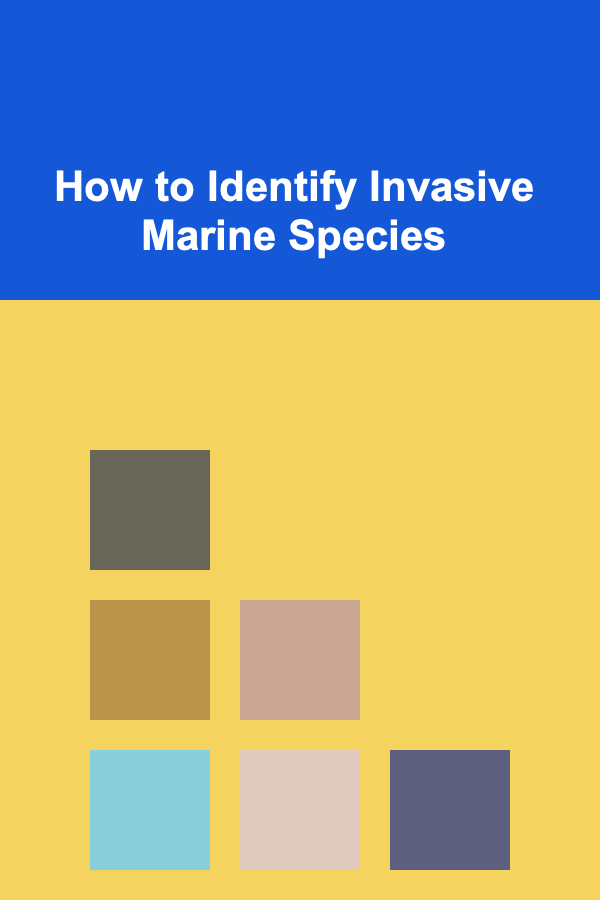
How to Identify Invasive Marine Species
ebook include PDF & Audio bundle (Micro Guide)
$12.99$5.99
Limited Time Offer! Order within the next:

Marine ecosystems are some of the most complex and diverse habitats on Earth. They support an array of life forms, from microscopic plankton to the largest animals, such as whales. These ecosystems also provide vital services, including oxygen production, carbon sequestration, and food sources for millions of people. However, the balance of marine ecosystems is fragile, and one of the greatest threats to marine biodiversity is the introduction of invasive species. These non-native species can outcompete native organisms, disrupt ecological balance, and cause economic damage.
Identifying invasive marine species is crucial for their management and control, which can help preserve marine biodiversity and the services it provides. This article will explore the ways to identify invasive marine species, the impact they have on ecosystems, and strategies for monitoring and managing them.
Understanding Invasive Marine Species
Before delving into the specifics of how to identify invasive marine species, it is important to understand what they are. Invasive species are organisms that are not native to a specific location and have the potential to cause harm to the environment, economy, or human health. In the marine context, invasive species are typically introduced to new environments through human activities such as shipping, aquaculture, and ballast water discharge.
Marine invasive species can be categorized into several groups, including:
- Invasive Fish: Species like the lionfish in the Caribbean and Indo-Pacific regions that prey on native fish and compete for resources.
- Invasive Mollusks: Species such as the zebra mussel or Asian clam, which can disrupt local ecosystems by outcompeting native mollusks.
- Invasive Crustaceans: These include species like the European green crab, which competes with native crabs and disrupts local fisheries.
- Invasive Algae : Algae species such as the green macroalga Caulerpa that can overtake native habitats, including seagrass beds and coral reefs.
- Invasive Marine Mammals or Birds: Some species, like the Indo-Pacific humpback dolphin, can displace native marine mammal populations.
These species have been introduced into non-native regions through shipping ballast water, intentional releases (such as for aquaculture), and accidental introductions via hitchhiking on ships' hulls or in packing materials.
Characteristics of Invasive Marine Species
Identifying invasive marine species requires an understanding of the general characteristics that differentiate them from native species. Although they can vary widely in terms of appearance, behavior, and ecological role, there are common traits that invasive species tend to share:
1. Rapid Growth and Reproduction
One of the most notable characteristics of invasive marine species is their ability to reproduce quickly and in large numbers. This allows them to establish populations rapidly, often outcompeting native species that reproduce more slowly. For example, the lionfish is known for its high reproductive rates, with females releasing thousands of eggs at once.
2. Resilience to a Range of Conditions
Invasive species are often more adaptable and resilient than native species. This trait allows them to thrive in environments that are less hospitable to other organisms. For instance, the European green crab has shown a remarkable ability to survive in a wide range of temperatures and salinities, giving it a competitive edge over native species.
3. Lack of Natural Predators
In their native environments, invasive species typically have natural predators that help regulate their population. However, when introduced into a new ecosystem, they often find themselves without these natural checks. Without predators or herbivores that feed on them, invasive species can grow unchecked and outcompete native species.
4. Aggressive Competition for Resources
Many invasive species are aggressive competitors. They are able to take over space or resources that native species depend on. This can lead to the decline or extinction of native species. For example, the Asian clam competes with native bivalves for food, space, and other resources, leading to the displacement of local species.
5. Ability to Alter Ecosystems
Invasive species can often alter the physical structure of ecosystems. For example, some species of algae can grow rapidly and form dense mats, blocking sunlight and depriving other organisms of essential nutrients. Similarly, the zebra mussel can clog water intakes and damage aquatic habitats by filtering large amounts of plankton from the water.
Methods for Identifying Invasive Marine Species
Identifying invasive marine species requires a combination of fieldwork, monitoring tools, and scientific analysis. The following methods are commonly used by scientists, researchers, and environmental agencies to identify invasive marine species:
1. Visual Identification
One of the simplest methods for identifying invasive marine species is through visual identification. This involves looking for unusual or unfamiliar species in marine environments. Visual identification is most effective in areas that are regularly monitored, such as coral reefs, estuaries, or coastal habitats.
Researchers and volunteers often participate in surveys, using their knowledge of native species and their distinctive characteristics. For example, the Indo-Pacific lionfish is easily recognizable by its long, venomous spines and unique coloration of red, white, and brown stripes.
Visual identification can be challenging, however, as many invasive species closely resemble native species. In these cases, it may require additional methods for confirmation.
2. Genetic Analysis
DNA barcoding is an effective way to identify invasive marine species. This method involves collecting a sample of tissue from the suspected invasive species and extracting its DNA. The DNA is then compared to a genetic database of known species to confirm its identity. Genetic analysis is particularly useful for identifying microscopic or cryptic species, such as plankton, that might be difficult to identify visually.
For example, scientists can use genetic markers to distinguish between different species of mussels, helping to identify invasive species that may otherwise go unnoticed in the ecosystem.
3. Environmental DNA (eDNA) Monitoring
Environmental DNA (eDNA) monitoring is a relatively new technique that has shown promise in detecting invasive marine species. In this method, researchers collect water samples from marine environments and extract any DNA that may be present in the water. Even traces of DNA left behind by organisms can be detected, allowing scientists to identify species in an area without having to physically capture or observe them.
eDNA is particularly useful for detecting elusive or rare species that may be difficult to spot, such as invasive fish or mollusks. It is also an effective method for monitoring large or remote areas, where it may not be feasible to conduct traditional field surveys.
4. Remote Sensing and Satellite Imagery
Invasive species often create physical changes in the environment, such as changes in water color or the appearance of large algal blooms. Remote sensing technologies, including satellite imagery, can be used to detect these changes. By analyzing satellite images and other remote sensing data, scientists can identify areas where invasive species are likely to be present.
For example, dense mats of invasive algae can alter the color of the water, making it possible to detect their presence using remote sensing techniques. This method allows for large-scale monitoring of marine environments and can help researchers prioritize areas for further study.
5. Citizen Science and Reporting Systems
Citizen science programs encourage members of the public to contribute to monitoring efforts by reporting sightings of unusual or unfamiliar marine species. These programs rely on non-experts to help identify and report potential invasive species, creating a network of observations that complement scientific research.
Online platforms, apps, and reporting systems have made it easier for people to document and share their observations. For example, the "Marine Invasive Species Reporting Program" allows anyone to report sightings of invasive species along coastlines, contributing valuable data to ongoing monitoring efforts.
6. Consulting Databases and Expert Networks
Identifying invasive marine species often involves consulting databases and expert networks that maintain up-to-date information about known invasive species. The Global Invasive Species Database (GISD), maintained by the Invasive Species Specialist Group (ISSG), is a key resource for researchers. These databases contain detailed information on invasive species' distribution, ecology, and potential impacts.
Consulting expert networks and collaborating with marine biologists, ecologists, and conservationists is another way to identify invasive species. These experts can help confirm sightings and provide insights based on years of research.
The Role of Invasive Species in Ecosystem Disruption
Once invasive marine species are identified, it is crucial to understand their impact on ecosystems. These species often disrupt the natural balance of marine environments in several ways:
- Biodiversity Loss: Invasive species can outcompete native species for food and space, leading to a decline in biodiversity. As native species decline or disappear, ecosystems become less resilient and less able to recover from disturbances.
- Habitat Destruction: Invasive species can physically alter habitats, making them unsuitable for native species. For example, invasive algae can cover coral reefs, smothering the coral and preventing it from receiving sunlight.
- Disruption of Food Webs: Invasive species can change the dynamics of marine food webs. Predatory fish such as the lionfish in the Atlantic Ocean have decimated populations of small fish, disrupting the food chain.
- Economic Impact: Invasive species can cause significant economic damage. For example, the zebra mussel has clogged water intake pipes in power plants and water treatment facilities, costing millions of dollars in repair and maintenance.
Conclusion
Identifying invasive marine species is a critical step in managing and mitigating their impacts on marine ecosystems. Through visual identification, genetic analysis, eDNA monitoring, remote sensing, and citizen science, researchers and environmental managers can monitor and track the spread of these species. Once identified, effective strategies can be implemented to control or remove invasive species and prevent further ecological disruption. Understanding the role of invasive species in ecosystem disruption is key to conserving marine biodiversity and ensuring the continued health of our oceans.

How to Create a Family Scrapbook of Seasonal Activities and Memories
Read More
How to Create a Master List of School Supplies for Each Grade
Read More
How to Maintain Your Home's Appliances for Better Efficiency
Read More
The Human Resources Assistant's Guide: Mastering the Essentials of HR Support and Administration
Read More
How to Review Horror Films for Suspense
Read More
How to Explore Genetic Modification in Medicine
Read MoreOther Products

How to Create a Family Scrapbook of Seasonal Activities and Memories
Read More
How to Create a Master List of School Supplies for Each Grade
Read More
How to Maintain Your Home's Appliances for Better Efficiency
Read More
The Human Resources Assistant's Guide: Mastering the Essentials of HR Support and Administration
Read More
How to Review Horror Films for Suspense
Read More